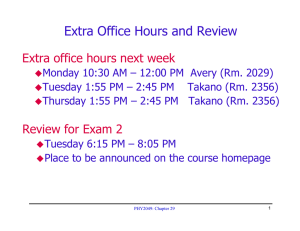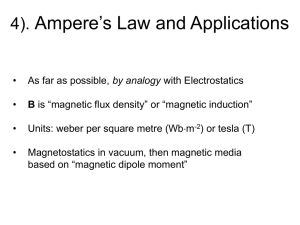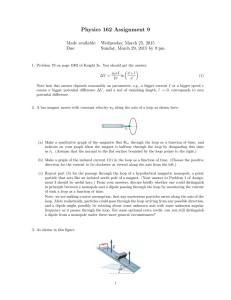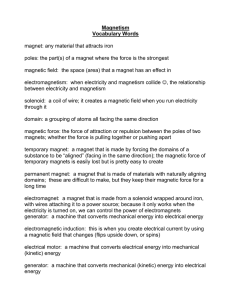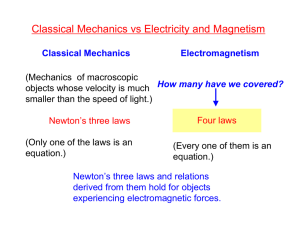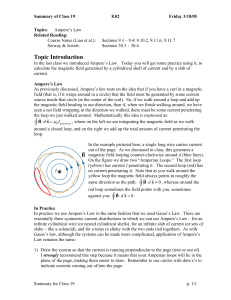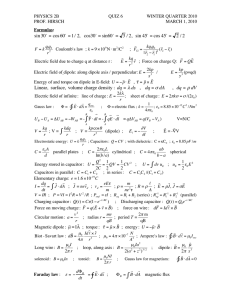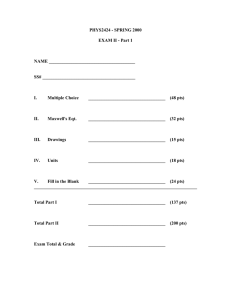Biot-Savart Law
advertisement
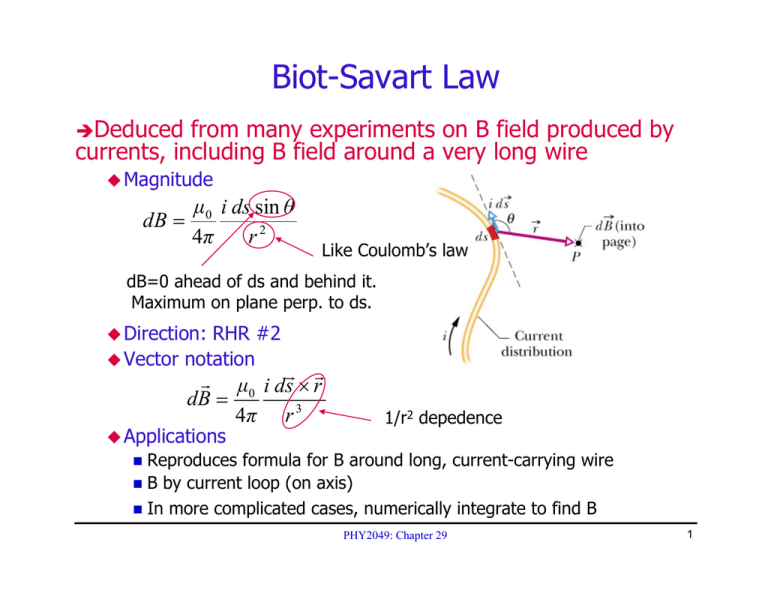
Biot-Savart Law ÎDeduced from many experiments on B field produced by currents, including B field around a very long wire Magnitude dB = µ0 i ds sin θ 4π r2 Like Coulomb’s law dB=0 ahead of ds and behind it. Maximum on plane perp. to ds. Direction: RHR #2 Vector notation r µ0 i dsr × rr dB = 4π r 3 Applications 1/r2 depedence Reproduces formula for B around long, current-carrying wire B by current loop (on axis) In more complicated cases, numerically integrate to find B PHY2049: Chapter 29 1 Law of Magnetism ÎUnlike the law of electrostatics, comes in two parts Part 1 Effect of B field on moving charge r r F = qv × B Part 2 Current produces B equivalent Biot-Savart Law Ampere’s Law Proof of equivalence not in the book (Require vector calculus and relies on the absence of magnetic monopoles) PHY2049: Chapter 29 2 B Field on Axis of Circular Current Loop ÎRadius R and current i: find B field at center of loop µ 0i B= From B-S law by integration 2R Direction: RHR #3 (see picture) B= µ0 i R2 2 R2 + z2 ( ) 32 ÎIf N turns close together N µ 0i B= 2R ÎB field on axis, including center µ0 i R2 B= 2 R2 + z2 ( z=0: ) 32 From B-S law by integration checks µ0 i R 2 B= z>>R: 2 z3 Like E field around electric dipole! PHY2049: Chapter 29 3 Current Loop Example Îi = 500 A, r = 5 cm, N=20 B=N µ 0i 2r = ( 20 ) ( 4π ×10−7 ) 500 2 × 0.05 = 1.26T PHY2049: Chapter 29 4 Field at Center of Partial Loop ÎDirection of B? ÎSuppose partial loop covers angle φ Calculate B field from proportion of full circle µ 0i φ B= 2 R 2π ÎUse example where φ = π (half circles) Define direction into page as positive µ 0i π B= 2 R1 2π µ 0i π − 2 2 π R 2 µ 0i 1 1 B= − 4 R1 R2 PHY2049: Chapter 29 5 Partial Loops (cont.) ÎNote on problems when you have to evaluate a B field at a point from several partial loops Only loop parts contribute, proportional to angle (previous slide) Straight sections aimed at point contribute exactly 0 Be careful about signs, e.g. in (b) fields partially cancel, whereas in (a) and (c) they add PHY2049: Chapter 29 6 Solenoid and Toroid ÎAnother Read application of Ampere’s law the book PHY2049: Chapter 29 7 FAQ on Magnetism (2) ÎAccording to the law of magnetism, a current produces a magnetic field, which exerts a force on a moving charge. In the phenomenon of two bar magnets attracting each other, I see no current in magnet 1 and no moving charge in magnet 2, and vise versa. Doesn’t this example show that the theory is incomplete? A: magnet 1 comprises magnetic ions, which produce magnetic field due to the orbital motion of electrons and the spins of electrons. Magnet 2 also comprises magnetic ions, in which electrons (negative charges) are orbiting around the nuclei and electrons are also magnetic dipole moments. The force between two magnets can be derived from the law, although the calculation is lengthy and you first need to derive the formula for the force exerted on a magnetic dipole by non-uniform B. PHY2049: Chapter 29 8
